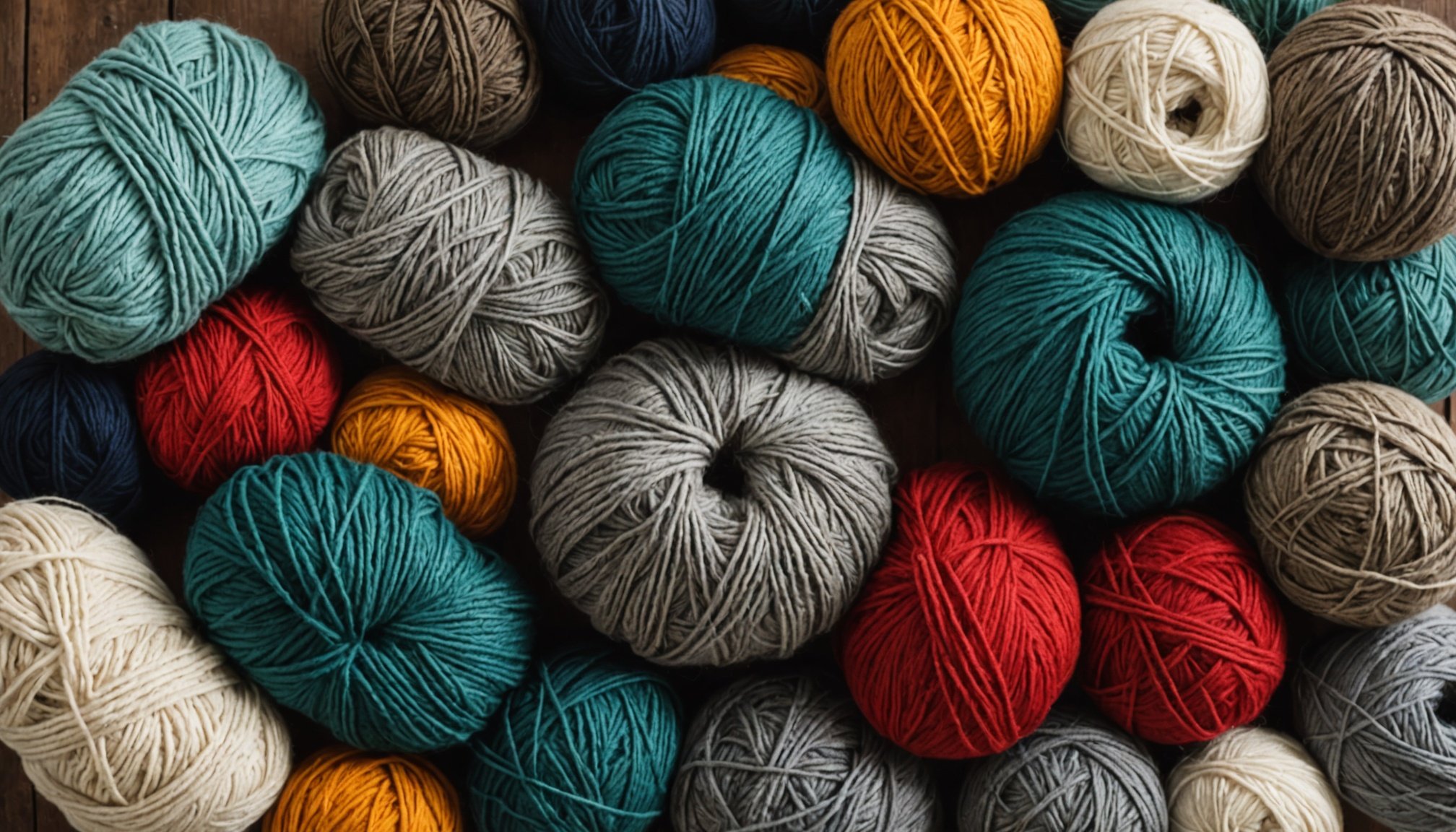The Ultimate Guide to Selecting the Perfect Wool for Your Bespoke Knit Sweater in the UK
When it comes to creating a bespoke knit sweater, the type of wool you choose can make all the difference. From the softness and warmth to the durability and sustainability, the right wool can elevate your knitwear to a whole new level. Here’s a comprehensive guide to help you navigate the world of wool and select the perfect yarn for your next knitting project.
Understanding the Different Types of Wool
Wool is not just wool; there are numerous types, each with its unique characteristics, advantages, and uses. Here are some of the most popular types of wool you might consider for your bespoke sweater:
This might interest you : How can I incorporate vintage pieces into my modern wardrobe?
Merino Wool
Merino wool is often praised for its softness, breathability, and temperature-regulating properties. It is finer than regular wool, making it less itchy and more comfortable against the skin. Merino wool is ideal for active wear and everyday sweaters due to its moisture-wicking abilities and quick drying time.
Cashmere
Cashmere is the luxury option, known for its exceptional softness and warmth. It is lightweight yet incredibly insulating, making it perfect for high-end knitwear. However, it comes with a higher price tag and requires more care than other types of wool.
Also to see : Ultimate Guide to Rocking a Long Cardigan for a Perfectly Cozy Day in the UK Countryside
Shetland Wool
Shetland wool is a classic choice for knitwear, particularly for traditional British sweaters. It is durable, crimped, and has a slightly rougher texture than merino wool. Shetland wool is great for creating a rustic, timeless look.
Rambouillet Wool
Rambouillet wool is another fine wool known for its softness and elasticity. It is often used in high-quality knitwear due to its ability to hold shape well and provide a smooth, even texture.
Factors to Consider When Choosing Wool
Selecting the right type of wool involves more than just picking a favorite; it requires considering several key factors.
Softness and Comfort
If you’re looking for a sweater that will be worn frequently, softness and comfort are crucial. Merino wool and cashmere are top choices here, but they come at different price points. For a more budget-friendly option, consider blends that include a high percentage of merino wool.
Durability
Durability is essential if you want your sweater to last. Shetland wool and other thicker wools are known for their robustness and can withstand regular wear and tear. However, they may not be as soft as finer wools.
Sustainability
For those interested in sustainable knitwear, look for yarns sourced from environmentally friendly and ethical suppliers. Merino wool from New Zealand and Australia is often considered sustainable due to the countries’ stringent farming practices.
Weight and Yarn Weight
The weight of the yarn will determine the thickness and warmth of your sweater. Here’s a brief guide to yarn weights:
| Yarn Weight | Description | Projects |
|---|---|---|
| Lace | Very fine | Lacy shawls, baby items |
| Fingering | Fine | Socks, gloves, baby items |
| Sport | Light | Baby items, lacy garments |
| Worsted | Medium | Sweaters, hats, scarves |
| Chunky | Thick | Quick knit projects, warm sweaters |
| Bulky | Very thick | Fast and warm projects |
Color and Dyeing
Consider the color palette you want for your sweater. Natural wools come in a range of colors, but if you’re looking for specific hues, you may need to opt for dyed yarns. Ensure the dyeing process is sustainable and does not compromise the quality of the wool.
How to Choose the Best Yarn for Your Project
Choosing the best yarn involves matching the type of wool with your project’s requirements. Here are some steps to help you make the right choice:
Determine Your Needs
- Purpose: Is the sweater for everyday wear, outdoor activities, or a special occasion?
- Climate: Will the sweater be worn in cold, mild, or warm weather?
- Comfort: How important is softness and itch-free wear?
Research and Read Reviews
- Look at reviews from other knitters to get a sense of how the yarn performs.
- Check the yarn’s specifications, including fiber content, weight, and recommended gauge.
Feel the Yarn
- If possible, touch and feel the yarn before purchasing. This will give you a sense of its softness, texture, and overall quality.
Consider Blends
- Sometimes, blends of different wools or fibers (like wool and cotton) can offer the best of both worlds in terms of durability, softness, and price.
Practical Insights and Actionable Advice
Here are some practical tips to keep in mind when selecting and working with wool yarns:
Clara Parkes on Yarn Selection
Clara Parkes, a renowned knitting expert, advises: “The best yarn for your project is one that aligns with your goals and preferences. Don’t be afraid to experiment with different types of wool to find what works best for you.”[4]
Swatching
Always swatch before starting your project. This will help you understand how the yarn will behave and ensure that your sweater fits as intended.
Care Instructions
Different types of wool have different care requirements. Make sure you understand how to wash, dry, and store your sweater to maintain its quality.
Detailed Comparison of Popular Wool Yarns
Here is a detailed comparison of some popular wool yarns to help you make an informed decision:
| Yarn Type | Softness | Durability | Sustainability | Weight Range | Price Range |
|---|---|---|---|---|---|
| Merino Wool | High | Medium | High | Fingering to Worsted | £10-£30 per skein |
| Cashmere | Very High | Low | Medium | Fingering to Worsted | £50-£100 per skein |
| Shetland Wool | Medium | High | High | Worsted to Chunky | £8-£20 per skein |
| Rambouillet Wool | High | Medium | Medium | Fingering to Worsted | £15-£35 per skein |
| Blends (Wool/Cotton) | Medium | High | Medium | Worsted to Chunky | £10-£25 per skein |
Examples and Anecdotes
Suzy Bonomini’s Knitwear
Suzy Bonomini, a London-based knitwear designer, often uses merino wool for her bespoke sweaters due to its versatility and comfort. She notes, “Merino wool is a favorite among my clients because it’s soft, breathable, and perfect for all seasons.”[1]
Sustainable Knitwear
For those interested in sustainable knitwear, brands like The Knotty Ones offer merino wool sweaters sourced from environmentally friendly suppliers. Their Laumės Beige Merino Wool Sweater is a great example of how high-quality, sustainable yarns can be used to create stylish and durable knitwear[3].
Choosing the perfect wool for your bespoke knit sweater is a journey that involves understanding the different types of wool, considering your needs, and making an informed decision. Whether you opt for the softness of merino wool, the luxury of cashmere, or the durability of Shetland wool, the right choice will ensure your sweater is not only stylish but also comfortable and long-lasting.
By following the guidelines outlined here, you’ll be well on your way to creating a sweater that meets your expectations and becomes a cherished piece of your knitwear collection. Remember, the best yarn is one that aligns with your project’s requirements and your personal preferences, so don’t hesitate to explore and find what works best for you. Happy knitting
Understanding Wool Types for Bespoke Knit Sweaters
When selecting wool types for bespoke knit sweaters, it’s essential to consider the qualities of Merino Wool, Shetland Wool, and Cashmere. Each type has unique characteristics that cater to different climates and personal preferences.
Merino Wool is renowned for its softness and versatility. It’s a favourite for those seeking comfortable, all-season sweaters. Merino fibres are breathable and moisture-wicking, making them ideal for both warm and cool climates.
Shetland Wool is hardy and textured, known for its durability. This type of wool is excellent for creating sweaters with a rustic and traditional feel. Given its robust nature, Shetland Wool is particularly suitable for colder climates and outdoor activities.
Cashmere stands out for its luxurious softness and warmth. The fibres are fine and lightweight, providing unmatched comfort. However, this comes with a higher price tag due to the labor-intensive process required to produce Cashmere.
When choosing the right wool, consider factors such as climate, desired texture, and budget. While Merino Wool offers versatility, Shetland Wool provides warmth and endurance. Cashmere delivers luxury for those who prioritise softness and elegance. By understanding these wool types, you can make an informed decision to create the perfect bespoke knit sweater.
Key Characteristics of Quality Wool
When assessing wool quality, it’s essential to look beyond the surface. The fiber strength and softness of the wool are crucial indicators of its overall durability. Strong fibers are less likely to break or pill over time, ensuring that your garments remain in excellent condition. Softness, on the other hand, directly affects comfort and wearability, making quality wool garments a delight to wear.
Fiber Strength
The durability of a wool garment heavily depends on the fiber’s strength. Higher quality wool typically has tightly packed fibers, which contribute to its robustness. This ensures that the fabric can withstand wear and tear without losing its form or integrity.
Softness and Comfort
Softness is another important characteristic, influencing not only the tactile sensation but also the longevity of the wool. Softer wool is often more comfortable, making it preferred for items like sweaters and scarves.
Processing Methods
It’s also vital to consider the impact of processing methods on wool characteristics. Poor processing can weaken fibers, reducing both strength and softness. Therefore, knowing how the wool was processed can give insights into its quality. Choose products where the processing enhances rather than diminishes the inherent qualities of the wool.
Sourcing Wool from UK Suppliers
When exploring high-quality wool, sourcing from UK Wool Suppliers is both a sustainable and practical option. By choosing Local Wool, consumers and businesses gain access to premium material while supporting local economies. This choice is especially beneficial for those who prioritise sustainability and ethical production practices.
Sourcing wool from Sustainable Sources in the UK offers numerous advantages. UK farms often adhere to environmentally friendly practices, reducing carbon footprints compared to international suppliers. This is particularly important to buyers concerned about climate impact and sustainability. UK-based farms typically maintain higher animal welfare standards, ensuring humane treatment of livestock.
Moreover, choosing local over international suppliers enhances traceability and transparency. This means customers are more informed about the wool’s origin and production process, contributing to a more trusted market. Purchasing from UK sources reduces transportation costs and associated emissions, offering a clear ecological benefit.
Comparing sourcing options, local wool surpasses international alternatives in both quality and sustainability. While international suppliers may offer lower costs, these often come at the expense of environmental impact and potential quality variations. In contrast, local UK suppliers provide a reliable and environmentally conscious choice for wool sourcing. Embracing local options fosters a robust sustainable economy, where high-quality wool is harmoniously produced with minimal ecological harm.
Care Instructions for Wool Sweaters
Caring for wool sweaters requires attention to detail to maintain their beauty and longevity. The first step is understanding the appropriate washing instructions. Handwashing is often the best approach. Use cold water and a gentle, wool-safe detergent. It’s crucial to avoid wringing or stretching, which can cause deformation.
When machine washing, select a delicate cycle and place sweaters in a mesh bag for protection. Avoid hot water and choose a low spin speed to reduce the risk of fibre damage. Always dry wool garments flat on a towel, away from direct heat sources like radiators or sunlight.
Awareness of common mistakes can help preserve your sweaters. Avoid frequent washing, as this can degrade the fibres, and steer clear of hanging wool items, which may lead to unsightly stretching. Instead, fold and store them with adequate space so they can breathe and maintain shape.
Lastly, to extend the life of bespoke knit sweaters, rotate wear and allow rest periods between uses. Regularly airing them out helps refresh the fibres without a complete wash. Incorporating these maintenance tips ensures your woollen garments remain soft, resilient, and part of your wardrobe for many years.
Addressing Allergies and Sensitivities
For those experiencing wool allergies, finding appropriate fabrics is crucial. Wool allergens, proteins found in the fibres, can lead to discomfort for sensitive individuals. Symptoms often include itchiness, redness, or even rashes upon contact.
Hypoallergenic fibres offer a respite from these reactions. Examples of alternatives include cotton, bamboo, or silk. These fibres lack the irritant proteins found in wool, making them ideal for those with skin sensitivity.
When selecting hypoallergenic fibres, consider textiles like Tencel or modal, derived from natural sources and processed to ensure gentleness on the skin. They provide moisture-wicking properties, keeping the skin dry and limiting irritations. Linen is another excellent choice for its breathability and softness, which can further alleviate sensitivity issues.
To discover suitable fibres without allergens, check labels and opt for fabrics explicitly marked as hypoallergenic. Conduct a patch test with any new material by placing it on a small area of skin to observe any reactions before committing to a purchase.
In conclusion, understanding wool allergies and knowing hypoallergenic fibres are essential steps in ensuring comfort for sensitive skin. By exploring these alternatives, both comfort and style can be comfortably achieved.
Practical Tips for Knitting with Wool
Understanding wool weight and the gauge is pivotal in crafting well-fitting sweaters. Wool weight is fundamental because it influences the drape and warmth of your knitted garment. When planning your sweater design, align your pattern’s suggested wool weight with your choice to ensure consistent results.
Gauge, or stitches per inch, determines the size of your final piece. Testing a gauge swatch before starting helps avoid ill-fitting garments. Knit a small sample of the stitches, measure its size, and adjust needle size accordingly to match the pattern’s gauge.
Different types of wool require unique knitting techniques:
- Chunky wool: Best for quick projects; use large needles to enhance its thick texture.
- Fine wool: Ideal for delicate, lace patterns; opt for smaller needles to maintain structure and detail.
Select patterns that complement your wool type. For example, using lofty wools in cable-knit styles enhances texture, while lightweight wools are suitable for airy shawls and pullovers. Matching these elements not only respects the character of the wool but ensures a beautiful and practical design. Whether you’re knitting for warmth or style, understanding these essentials transforms your project into a work of art.











